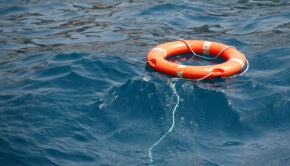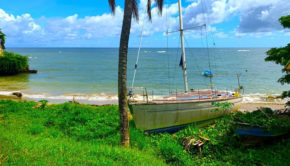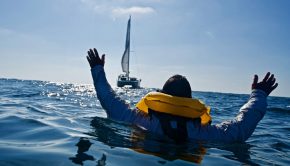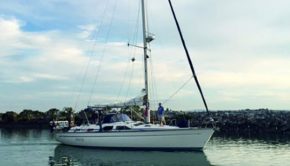Overboard: Stories from off the boat
Published on May 8th, 2019
Falling overboard can occur unexpectedly and end tragically. Staying onboard is always a priority, but even the most experienced can find themselves off the boat. Warwick ‘Commodore’ Tompkins shares his experience.
The three of us – Dave Wahle, (Santa Cruz, CA), a friend of his new to me, and myself – were delivering a 40-foot Derecktor design from New York to Florida. It was late January 1969, there had been ice on the East River at departure, but on the morning in question, we had just entered the Gulf Stream, it seemed tropical on board.
We were carrying the main and a poled-out headsail, running fast in 25 knots and accompanying seas. The boat was surfing regularly. Dave was at the tiller, our third in his bunk, and I was shaving, having just turned over the watch to Dave. Bright sunny day, really glorious as I recall.
Dave is strong and a great sailor who loves to surf (Who doesn’t?). From down below I was aware of the repeated surfing, and knew that the rudder, which had little or no balance, grew heavy on occasion. I had seen Dave standing with one leg on the lee cockpit seats and forcing the tiller to windward with his hip to maintain course and initiate the surf.
But suddenly I felt a deeper than usual lurch, greater heel, some rotational movement accompanied by a cry of “Help!” from the cockpit.
In very short order I was in the cockpit, viewing Dave afloat and growing more distant in our wake. Number three came through the hatch after me, showing confusion and probably fear. I instructed him to put his butt against the main gooseneck/mast junction, hold on and not to lose sight of Dave.
I proceeded to let the jib halyard run, the boat had by herself assumed a beam reach, and, luffing, lost most of her way. Now the headsail dropped off the headstay and from the end of the pole, windage but not effective as a sail.
Having sailed catboats a lot, which was what this boat was now, I knew to only slowly trim in the main to gather headway and steerage. When I had enough steerage, I asked number three to point to Dave, took a rough bearing on the direction he indicated, and told him to hang on while I tacked to reverse course.
Number three resumed his position at the mast, and stated that he could no longer see Dave, which was obviously because he was looking in the wrong direction.
Using the bearing, I sailed slowly back, stopped the boat slightly to windward and hauled Dave aboard through the leeward lifelines. He had been overboard for less than ten minutes. He was glad to be back onboard, but upset because he had lost a boot!
In the debriefing, Dave reported that a sea had broken under the weather quarter, heeling the boat, (increasing helm), and that the tiller had simply catapulted him out of the cockpit. He took parts of the dodger and a lifeline with him on his way overboard.
The recovery process owed its success to readily/quickly adjusting the sail plan for maneuverability, knowing how to generate steerage way, a boat that was balanced enough to steer well, the compass bearing, the water-temperature and, very importantly, Dave’s strength and cool head while adrift. His strength helped in getting him over the lee rail. For the most part, cool heads prevailed… another major factor.
One of Dave’s seamanship secrets is that he rigs his boots so that he can tie them together at the back and top. On this occasion, he slipped beneath the surface, removed the boots and tied them to one another. He reports that underwater it was beautiful and quiet. Back at the surface, he emptied the boots and placed them front and back with the cordage through his crotch, making a very effective water wings.
Nobody was wearing lifejackets; their omission was not a problem on this occasion.
——————–
Scuttlebutt wants to feature your overboard experience. Send to editor@sailingscuttlebutt.com.









 We’ll keep your information safe.
We’ll keep your information safe.